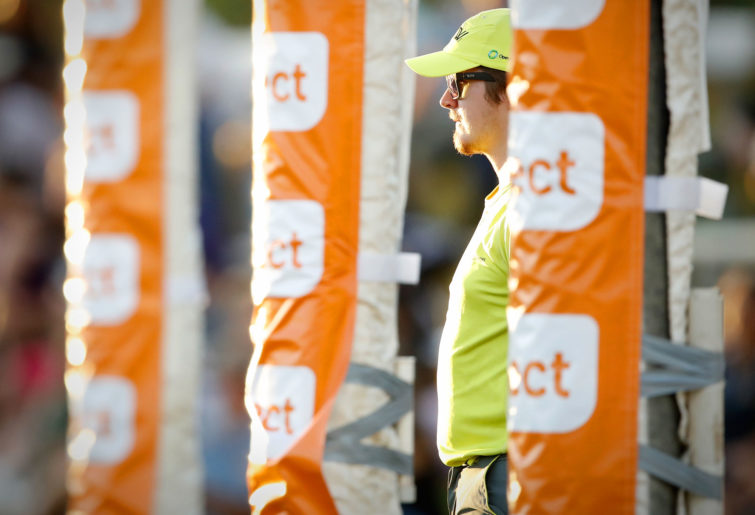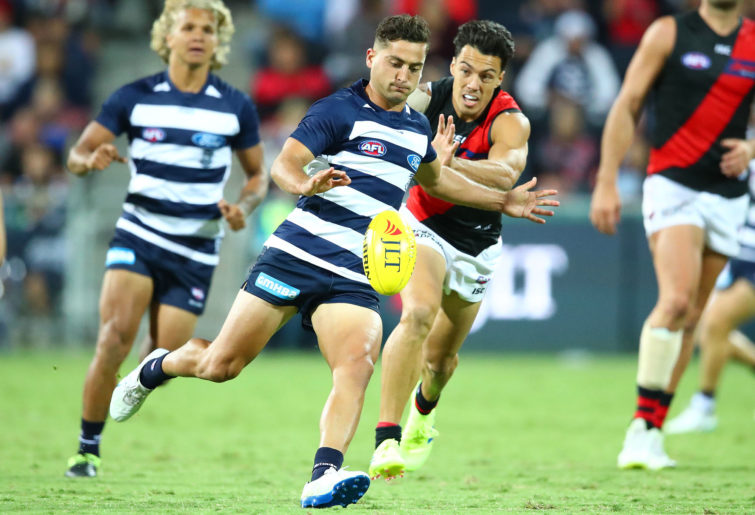WATCH: 'Oh my word!' Big Giant launches MONSTER torp for epic VFL goal
Outstanding from Nicholas Madden!
I was raised to never talk about religion or politics in public yet these days I discuss both of them professionally. So let’s talk about the umpiring of the new rules this season.
The first thing to say is that even the Hayden-est hater out there on Twitter – I’m looking at you, Mr Ballantyne! – doesn’t put the entire burden for the perceived issues of regulating the footy field on the men and women in yellow (and I don’t mean Richmond). It’s hard to put the entire blame on the suits at headquarters too.
We need to start by looking at the philosophy of professional sport.
When we play sport for fun, even at organised youth levels, officiating isn’t important. You’re playing for the joy of playing, for the camaraderie and for the athletic exertion and skill development. Call your own penalties, have some parents help, let the odd man out settle disputes. Nothing of import hinges on the outcomes.
But at the professional levels – in fact at any level on which the spectators outnumber the participants by more than double, which includes most Gold Coast games – there has always been an expectation that the game is ‘fair’ for both teams, that word sometimes being a bit subjective by its nature. The job of the rule writers is to make ‘fair’ objective and straightforward for players, coaches and umpires.
In the case of Australian Rules football, this created a game that stayed relatively stable through the bulk of the 20th century, and that’s the game most of us think of as the ‘traditional’ game. Most of the rules were ‘instinctive’.

(Adam Trafford/AFL Media/Getty Images)
And then something new and important came to the forefront, not just in footy but in every contact sport. As entertainment money began to arrive in major sports, the players began to become more valuable to the clubs. As investment in teams grew, the care for the wellbeing of players became more and more important.
What that forced is a revision of the rules of the game – again, not just in Aussie Rules but in all forms of football, as well basketball, hockey and even less violent sports like baseball and volleyball. These revisions came purely with the safety of the players in mind. Some of those rule changes seemed natural; others not so much.
The difficulty we’re dealing with right now on this front is the conflict that arises between the ‘traditional’ and the ‘safe’. When you tackle a player high, is it always a situation in which the ball-carrier is in danger or is there room for umpire discretion – and, if so, is that where you want the discretion to take place?
If you’re Nic Newman kicking at a ball when there’s a player on the ground, as was the case with Lance Franklin going after the Sherrin in the Sydney game against Carlton last week, should there be a penalty paid against you (the ‘safe’ position), or is that just the price Buddy pays for throwing his body into the game (the ‘traditional’ position)?
The situation in the AFL and its fellow professional leagues right now is that we have not yet come to an agreed balance between safe and traditional. That’s understandable – neither have most of the other sports named.
American football is dealing with the kickoff, a play where the two teams run at each other from 60 yards apart and collide at full speed while a return man either calls for a fair catch, lets the ball fly through the end zone or attempts a runback that rarely involves more than a handful of those colliding blockers and tacklers.
A rival league that just folded eliminated the kickoff entirely without any negative consequences; I’ll be surprised if the NFL doesn’t do the same within five years. Purists will balk, but the coaches and players will love the change.
The American equivalent of the high tackle controversy is the protection of the quarterback, the highest-paid player on the roster. At times it feels like there’s bubble wrap surrounding the passer, and the poor rushers are forced into a delicate dance of stopping the quarterback without putting him in any physical danger whatsoever. It’s changed the game tremendously. Not everyone believes it’s for the best.
The other major agent of injury-based change for the US version of the game is the same one we’re just beginning to deal with here over the last few years: concussions. While we’re only now seeing players like Liam Picken ending their careers earlier than they might have in years past, the NFL has already seen a completely different phenomenon of players retiring before they’ve had any concussions in order to prevent brain damage.
In the last decade the San Francisco 49ers alone have lost tackle Anthony Davis and linebackers Patrick Willis and Chris Borland to ‘preventative retirement’. Borland is an especially worrisome case because he played just one year in the NFL, was named to an all-star team and immediately retired at the age of 25 rather than subject himself to possible trauma.
An infamous study of 111 brains from deceased NFL players showed that all but one had significant brain damage from chronic traumatic encephalopathy (CTE), which is caused by repeated blows to the head. The damage causes horrific symptoms, and it’s been shown present in participants in virtually every contact sport, including soccer and volleyball.
We already see the effects affecting some players. We cannot protect them completely from the possibility of head trauma, but many of the recent rule changes have been attempts to protect players from such injuries. Finding the balance between a game that allows the leaping marks and flying rucks that we’re used to seeing and the game that protects the brains and bodies of our players will always be a challenge.

(AAP Image/Julian Smith)
There’s another reason for implementing rule changes, this one the motivator for the most recent set of adjustments including the 6-6-6 and the way the 50-metre penalty has been implemented this season, and that’s the idea of ‘modernising’ the game. The AFL is hoping to open up the game again, reduce the Sydney-style scrums and increase not only the scoring but the long kicking game. It’s about bringing in more of the spectacular and reducing the mundane.
But change never comes without bumps, and while the league creditably did more than its due diligence in preparation for implementing these rule changes, both on the technical and the PR fronts the bumps are causing consternation across the board. The interference with the mark by the defensive player after either a mark or a previous penalty is causing more new penalties or extensions of penalties than anyone wants.
Is that the fault of the rules makers for not designing the rules correctly? Is it the fault of the umpires for calling the rules too tightly? Is it the fault of the coaches for not teaching the changes sufficiently or appropriately? Is it the fault of the players for not adhering to those new rules seriously enough?
As is almost always the case, the answer to all of the above is yes.
More importantly, what’s the solution?
My contention is that the solution must always go back to the original purpose of the rule changes. What was the intent of the rule? What punishment would enforce the change you’re seeking to implement?

(Scott Barbour/Getty Images)
Let’s use a rule that was a problem last year: the declaration of a ruck on boundary throw-ins. It was the 2018 enforcement that, without a declared ruck for a throw-in, became a free kick for the opposing team, which seemed severe for what at worst was a minor communication error.
The penalty didn’t match what the perceived severity of the situation was, so they changed either the rule or the enforcement (frankly, I don’t know which), and now it’s thrown in with the best intents and come what may. More than 90 per cent of the time, as before, it’s the two ruckmen who go after the ball anyway, but there have been cases already this year in which the Sherrin has landed well short and a midfielder’s been the first to attend to the ball. Penalty? Not this season – play on, it’s not a big deal; nobody’s going to get hurt and it speeds the game up this way. A perfect solution.
When it comes to the 50-metre penalty change, however, I suspect nobody’s happy about it yet. So ask: what was the purpose of changing the enforcement of the 50?
The instructions were for the umpires to be “stricter on the infringing player, allowing the player with the ball to advance the mark by 50 metres without the infringing the player delaying the game. In addition, the player with the football will be able to play on during the advancement of the 50-metre penalty.”
My question is: why? What is the purpose of the rule and what is the punishment being enforced trying to implement in the game?
Does it improve the health and safety of the players? I can’t imagine how.
Does it open up the game? Arguably it will increase scoring, but I don’t think it’s doing so in a positive way. It introduces randomising scores that distort the ‘fair’ outcome of the game, and I cannot believe that was ever the intent of the rule-makers, nor of the officials asked to implement the rule.
The principle I suspect they wanted to implement is straightforward. If you’re trying to speed up the game, speeding up the enforcement of penalties sounds like a harmless way to do it. And the rule is straightforward enough as well – stay out of the imaginary box delineated by the line between player and mark, with (and here’s the problem) an indeterminate width to either side of that line.

(Bradley Kanaris/Getty Images)
In most cases where the penalty’s been implemented one of two things has happened: someone’s crossed the line (an obvious violation; deal with it, defenders, and start paying attention) or someone’s pushed into that box, in which case I have great sympathy for the player it’s called on. There was a Carlton game in the AFLW against Geelong during which that second kind of violation handed them victory – Maddie Boyd was given a 50 for a violation by one of the Cats, and don’t ask which one because I didn’t know who it was then and I don’t know today.
Here’s one of those ‘objective’ criteria I’d suggest: if you can’t figure out who the penalty was on when watching the game, there’s something wrong.
This is a case where something concrete has to be done with the rule. The simplest change is to eliminate the ‘box’ and just protect the line of sight between player and mark while asking the umpires to be more generous with their assessments of whether a defender is really impeding the player with the mark. The more effective solution is to eliminate the change entirely.
Eliminating the ability to charge forward past the penalty distance seems to be a no-brainer as well. That rule fulfills none of the purposes we outlined here. I compare it to the thought of having a rule in basketball where if you step over the line on the side of the key, the shooter gets to move forward and dunk the free throw.
To summarise: the principle behind any rule should be to improve the game over not having the rule in place. Phase 1, the creation of the game itself, is long complete.
Phase 2, the protection of the players, continues as the technology and available equipment improves, as science discovers more about how to protect players and as the different parties involved choose to enforce those protections. Right now we’re in a resurgence of Phase 2.
Phase 3, the choices made to improve the game for the modern viewer and participant, seems to go through waves, and we’re in one of those waves right now.
So with two conflicting sources of rule changes going on, it’s imperative that we take the root reasons for these changes to heart, consider if the rules as we’re implementing them are correctly addressing those reasons and adjust the rule, the enforcement or the coach and player reaction to those rules as necessary.